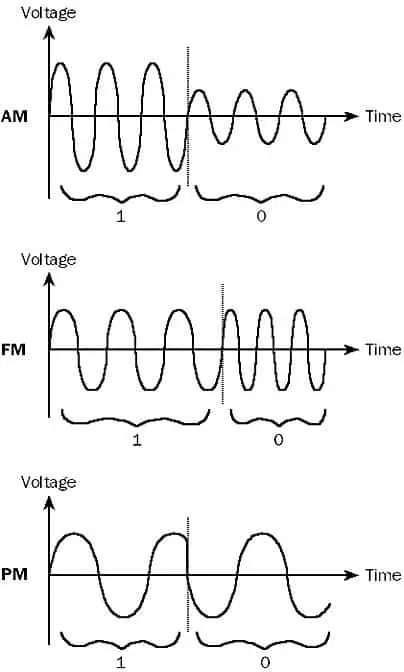Definition of modulation in Network Encyclopedia.
What is Modulation (in computer networking)?
Modulation is the process by which information is encoded into electrical signals for transmission over a medium. Binary information, as represented by a series of 1s and 0s, must be converted to analog or digital electrical signals for transmission.
For analog transmission over voice-grade Public Switched Telephone Network (PSTN) lines, this process is usually called “modulation,” and for transmission over digital lines, the term “line coding” is often used instead.
Modulation forms the basis of the digital-to-analog converter (DAC) component of an analog modem. Modulation in modems allows digital binary information to be received from a serial interface on a computer and modulated for transmission over the voice-grade PSTN telephone network.

Three types of signal modulation for analog signals can be used:
- Amplitude modulation (AM): Carries information by modulating the amplitude (voltage) of the carrier signal. Different amplitudes represent different information values. For example, an amplitude of 3 volts might represent a 1, while an amplitude of 1 volt represents a 0.
- Frequency modulation (FM): Carries information by modulating the frequency of the carrier signal. Different frequencies represent different information values. For example, a frequency of f might represent a 1, while a frequency of 2f represents a 0. A common frequency modulation scheme in modem technologies is called frequency-shift keying (FSK), in which four frequencies within the PSTN 3-KHz line bandwidth are used for the transmission and reception of binary data, as shown in the following table.
Frequencies Used in FSK Modulation
| FSK Frequency | Meaning |
| 1070 Hz | Transmitted binary 1 |
| 1270 Hz | Transmitted binary 0 |
| 2025 Hz | Received binary 0 |
| 2225 Hz | Received binary 1 |
- Phase modulation (PM): Carries information by modulating the phase of the carrier signal. Different phases represent different information values. For example, a phase of 0° might represent a 1, while a phase of 180° represents a 0. A common implementation of phase modulation in modem technologies is called differential phase-shift keying (DPSK), in which relative phase changes instead of absolute phase values are used to represent encoded binary information. Quadrature amplitude modulation (QAM) allows the encoding of pairs of binary values as different phase values, as shown in the following table.
QAM Encoding of Binary Value Pairs
| QAM Phase Value | Binary Information Represented |
| 45° phase shift | 11 |
| 135° phase shift | 10 |
| 225° phase shift | 01 |
| 315° phase shift | 00 |
For modulation (line coding) over digital transmission lines, you can use various techniques, depending on the networking technology. For example,
- Manchester coding is the standard line coding technique used for standard Ethernet networks.
- Carrierless amplitude and phase (CAP) modulation is an older Digital Subscriber Line (DSL) line coding technology. CAP has been largely replaced by discrete multitone (DMT) modulation, which is endorsed for Asymmetric Digital Subscriber Line (ADSL) use by the American National Standards Institute (ANSI) and for DSL-Lite by the International Telecommunication Union (ITU), and includes error-correction functions that CAP does not. A newer variant is discrete wavelet multitone (DWMT) modulation, which is used for Very High-Rate Digital Subscriber Line (VDSL) implementations.